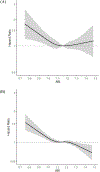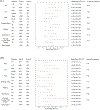Peripheral artery disease and risk of kidney outcomes: The Atherosclerosis Risk in Communities (ARIC) study
- PMID: 39276420
- PMCID: PMC11467911
- DOI: 10.1016/j.atherosclerosis.2024.118558
Peripheral artery disease and risk of kidney outcomes: The Atherosclerosis Risk in Communities (ARIC) study
Abstract
Background and aims: The potential impact of peripheral artery disease (PAD) on kidney outcomes is not well understood. The aim of this study was to explore the association between PAD and end-stage kidney disease (ESKD) and chronic kidney disease (CKD).
Methods: Among 14,051 participants (mean age 54 [SD 6 years]) from the Atherosclerosis Risk in Communities study, we categorized PAD status as symptomatic PAD (intermittent claudication or leg revascularization), asymptomatic PAD (ankle-brachial index [ABI] ≤0.90 without clinical history of symptoms), and ABI 0.91-1.00, 1.01-1.10, 1.11-1.20 (reference), 1.21-1.30, and >1.30. We evaluated their associations with two kidney outcomes: ESKD (the need of renal replacement therapy or death due to kidney disease) and CKD (ESKD cases or an estimated glomerular filtration rate (eGFR) < 60 mL/min/1.73 m2 with a ≥25 % decline from the baseline) using multivariable Cox proportional hazards models.
Results: Over ∼30 years of follow-up, there were 598 cases of incident ESKD and 4686 cases of incident CKD. After adjusting for potential confounders, both symptomatic PAD and asymptomatic PAD conferred a significantly elevated risk of ESKD (hazard ratio 2.28 [95 % confidence interval 1.23-4.22] and 1.75 [1.19-2.57], respectively). Corresponding estimates for CKD were 1.54 (1.14-2.09) and 1.63 (1.38-1.93). Borderline low ABI 0.91-1.00 also showed elevated risk of adverse kidney outcomes after adjustment for demographic variables. Largely consistent results were observed across demographic and clinical subgroups.
Conclusions: Symptomatic PAD and asymptomatic PAD were independently associated with an elevated risk of ESKD and CKD. These results highlight the importance of monitoring kidney function in persons with PAD, even when symptoms are absent.
Keywords: Ankle-brachial index; Atherosclerosis; Chronic kidney disease; End-stage kidney disease; Peripheral artery disease.
Copyright © 2024 Elsevier B.V. All rights reserved.
Conflict of interest statement
Declaration of competing interest The authors declare the following financial interests/personal relationships which may be considered as potential competing interests: K.M. reports personal fees from Fukuda Denshi and Kowa Company, Ltd. Outside of the submitted work. The other authors do not have relevant conflicts of interest.
Figures




References
-
- Song P, Rudan D, Zhu Y, et al. , Global, regional, and national prevalence and risk factors for peripheral artery disease in 2015: an updated systematic review and analysis, Lancet Glob Health, 2019;7:e1020–e1030. - PubMed
-
- Criqui MH, Langer RD, Fronek A, et al. , Mortality over a period of 10 years in patients with peripheral arterial disease, N Engl J Med, 1992;326:381–386. - PubMed
-
- Gerhard-Herman MD, Gornik HL, Barrett C, et al. , 2016 AHA/ACC Guideline on the Management of Patients With Lower Extremity Peripheral Artery Disease: Executive Summary: A Report of the American College of Cardiology/American Heart Association Task Force on Clinical Practice Guidelines, Circulation, 2017;135:e686–e725. - PMC - PubMed
Publication types
MeSH terms
Grants and funding
- R01 HL146132/HL/NHLBI NIH HHS/United States
- HHSN268201700004C/HB/NHLBI NIH HHS/United States
- T32 HL007024/HL/NHLBI NIH HHS/United States
- HHSN268201700001I/HL/NHLBI NIH HHS/United States
- HHSN268201700004I/HL/NHLBI NIH HHS/United States
- HHSN268201700003I/HL/NHLBI NIH HHS/United States
- HHSN268201700005C/HL/NHLBI NIH HHS/United States
- HHSN268201700001C/HL/NHLBI NIH HHS/United States
- HHSN268201700002C/HB/NHLBI NIH HHS/United States
- HHSN268201700003C/HL/NHLBI NIH HHS/United States
- HHSN268201700002I/HL/NHLBI NIH HHS/United States
- HHSN268201700005I/HL/NHLBI NIH HHS/United States
LinkOut - more resources
Full Text Sources
Medical
Research Materials
Miscellaneous

